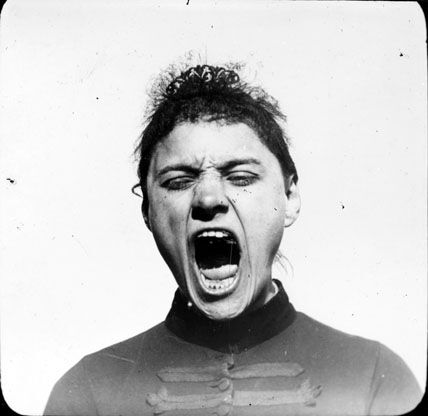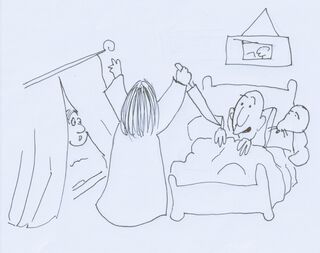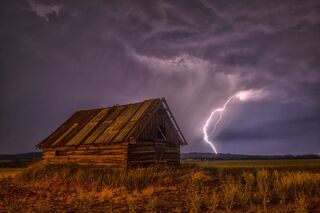Health
(Too) Little House on the (Verge of) Prairie (“Madness”)
Depictions of mental disorder on the frontier.
Posted August 16, 2020 Reviewed by Matt Huston

According to the Oxford English Dictionary, the 19th Century saw the term “prairie madness” enter the vernacular of the time and become a catch-all phrase for depression and other mental health concerns experienced by settlers on the American great plains during westward expansion.
An episode of this phenomenon appears in the somewhat ironically named These Happy Golden Years, the 4th of the Little House books by Laura Ingalls Wilder. While the book does end on a rather cheerful note, many bleak and unhappy things occur during the narrative. Foremost among these is Laura’s first post as a school teacher at age 15. Far from home and staying with a peculiar family, the Brewsters, Laura encounters a maternal figure quite unlike Ma back home. The lady of the house, Mrs. Brewster, is portrayed as a sourly uncommunicative, frequently irritated and at times desperate woman who seems to finds her role as wife and mother on the remote Dakotas prairie almost insufferable. The up by their corset-straps approach the Ingalls family typically employs seems to be unknown to her.
Laura valiantly attempts to connect with Mrs. Brewster by lending a hand with chores and trying hard to stimulate cheery conversation. This is to no avail, however. Mrs. Brewster seems to view her unexpected house guest as just another of the horrid annoyances of her miserable lot in life. Laura settles into uneasy coexistence as an unwelcome boarder, counting the days until she can return home for good.
One night, however, in a chapter ominously entitled “A Knife in the Dark,” Laura is abruptly awakened by the clamor (only a few feet away on the other side of an improvised curtain partition) of a loud quarrel between the two other adults in the house. She peeks through the makeshift barrier and is horrified to see an apoplectic Mrs. Brewster looming above the still-in-bed Mr. Brewster, a large butcher knife in hand, seemingly poised to plunge it into Mr. Brewster’s flesh. He rather deftly talks Mrs. Brewster out of committing homicide, and she resentfully mutters her way back to the kitchen and puts away the knife. There is no more commotion that night; nonetheless, Laura lies eyes-wide awake until dawn listening for trouble. She only spends a handful of further nights with the Brewsters and witnesses nothing this extreme again.

While all this is likely a frightening interlude for young readers, an adult reader can appreciate the faint dalliance with black comedy of this episode. Throughout the Little House books Laura creates a narrative of the plucky and deadpan heroine reacting to the many addled adults all around her. As an Adlerian in orientation, I am fascinated by the way in which Wilder’s childhood is remembered in late adulthood. As James Thurber reportedly once said, “humor is emotional chaos remembered in tranquility.”
But What About Mrs. Brewster?
A very young child is mentioned as part of the Brewster brood. Mrs. Brewster could well have been suffering from a postpartum depression exacerbated by poor nutrition, inadequate sleep, a lack of support from her husband, being cooped up in a rough shack far from civilization as she defined it, and burdened by the same monotonous toil each day. Mrs. Brewster outwardly longs, begs and threatens mayhem for the opportunity to go “back east." Had there been an alienist in the area, he might well have rendered a diagnosis of melancholia agitata. Much has been written about the pathologizing of female behavior in the 19th Century, and a review of some of the historical data would suggest that women were frequently institutionalized for behaviors of considerably less consequence than near murder. Arrangements indeed might have been made to send her back east, but perhaps only so far as the state asylums in Minnesota or Iowa.
It is easy to categorize Mrs. Brewster’s behaviors as consistent with the prairie madness narrative. What has been described as the EcoGothic tradition (in which man sees the unyielding environment itself in which he has placed himself to be oppressive, harsh and fraught with menace) extends far back in literature as an element in many accounts of people encountering an unknown land, but found a particular piquancy in tales and remembrances of the grim and rugged westward expansion in the United States. A 2009 essay by Simon Estok defined the term ecophobia as the “contempt and fear we feel for the agency of the natural environment.” Mrs. Brewster may well have felt something much like this.
In countless novels, short stories and poems, from Willa Cather’s O’ Pioneers to James Michener’s Centennial and more recent representations in films like 2014’s The Homesman and 2018’s The Wind, the supposed prevalence of the deranging consequences of pursuit of manifest destiny among women (and not a few men) on the frontier has been a common plot device. Isolation far from family and other systems of support, constant threat of ruin (and attendant starvation) from weather or insect infestation, the never-ending striving to stretch meager resources, rearing children (who could be taken off by sickness with little warning), and the extremes of biting cold and infernal heat are indeed rather a formula for trauma and despair. The incessant noise of the howling winds on the flat, treeless plains might even have aggravated latent misophonia.

About a century and more has passed and the notion of “prairie madness” has long since left the dialogue (aside from appearances in popular entertainment). The prairie itself has been all but conquered, yet the same essential problems besetting the nation’s pioneers in dealing with mental and emotional disorders remain shockingly widespread in modern America. (Mrs. Brewster might only be marginally better off today.) Current challenges in rural mental health care delivery continue to be marked by the lack of an adequate workforce, stigma related to seeking help, affordability of care and transportation obstacles. Telehealth may eventually do much to ease the situation, but is still limited by shortages of providers and inadequacies in broadband in many regions.
More information about contemporary rural mental health can be found here. Additional insight about mental health care in the 19th Century can be located here.
References
Unsettling Landscapes: Prairie Madness and EcoGothic Themes in US Plains Literature
Vanessa Steinroetter
Great Plains Quarterly, Volume 39, Number 3, Summer 2019, pp. 291-310
(Article)
Published by University of Nebraska Press
DOI:


